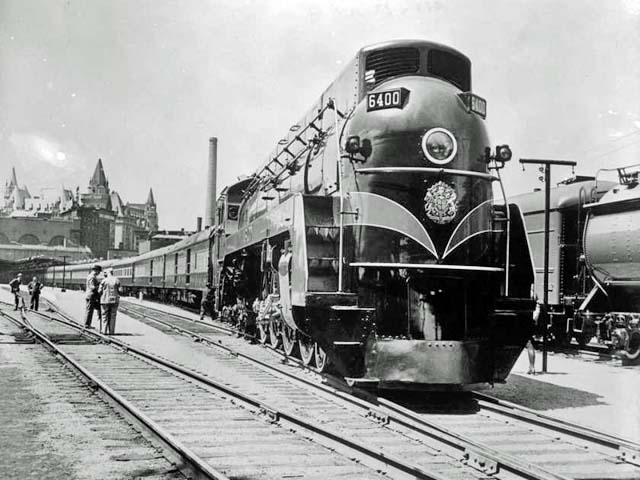
Canada - Train prepared for King George VI and Queen Elizabeth was perfect, except for the European pictures.
"A hundred thousand citizens of the greatest city in the greatest Dominion in the Empire expressed their loyalty for their King and Queen this afternoon
as the royal couple arrived from the Ancient Capital.
Streets were jammed for blocks hours before the blue and silver royal train puffed into Jean Talon station."
Gazette, Friday, 19 May 1939.
The month-long tour of Canada, with side trips to Newfoundland and the United States, was the first by a reigning British monarch.
Most of it would be by rail, for this was still the way to travel long distances in Canada, for king and commoner alike.
Fortunately, the main railroads, the Canadian Pacific and the Canadian National, spanned the continent.
They were used to thinking in grand terms.
They were also used to putting on special tours for their own panjandrums.
The annual tour of inspection by the CPR's president, Sir Edward Beatty, had its own whiff of royal progress about it, if only for the CPR underlings across
the country who were charged with organizing it.
King George VI and Queen Elizabeth, later the Queen Mother, landed at Quebec City on 17 May 1939.
Most of the westbound leg of their tour, through Montreal and on to Vancouver, was over CPR tracks with CPR locomotives, while the return was mainly the CNR's
responsibility.
The 12 cars of the train itself, however, were a mixed bag.
Seven were from the CPR, three from the CNR, and two, occupied by the king and queen and their attendants, were the private cars of the
governor-general.
For weeks before the tour actually began, tradesmen at the CPR's Angus shops east of Mount Royal, and the CNR counterpart in Point St. Charles, scurried to get
the cars ready.
The finest of panelling, curtains, and carpeting had to be installed.
Tables, chairs, and other furniture could not show the least sign of wear.
There was china and silverware to be seen to.
Office space was fitted up, and the air-conditioning, telephones, and back-up power generation had to function perfectly.
A few days before the train was sent to greet the king and queen in Quebec City, CNR and CPR employees who had worked on it were allowed to show off their
handiwork to their families.
Margaret Adcock of Verdun well remembers her father, a skilled tile-setter for the CNR, taking her to see the train.
"Can you imagine such a thing happening in this day and age?" she asks.
Even outsiders like a bustling Montreal businessman named Albert Kyle managed a viewing.
Kyle got in touch with his friend H.B. Bowen, who was chief of rolling stock for the CPR.
Who better to arrange matters?
Through the long stretch of cars they went, the baggage car, a sleeping car for the train crew, a dining car, a business car, three compartment cars, two
sleeping cars, the private car of Prime Minister Mackenzie King, and finally the royal party's two cars.
And there, Kyle's granddaughter Heather Shaw recalls, the trouble started.
Kyle was horrified to see lithographs of European scenes hanging on the walls.
Why not paintings by Canadian artists, he demanded.
Right there, Kyle decided to act.
Audaciously, he announced to Bowen and his colleagues that he was going to round up proper Canadian paintings to replace the offending European
ones.
Hold on, he was told.
You'll need permission from the governor-general, Lord Tweedsmuir.
Unfazed, Kyle dashed off a telegram to Rideau Hall in Ottawa, then without waiting for a reply, went looking for the art he wanted.
Remarkably, it took him little more than a day.
Three prominent artists told him they'd be delighted to contribute.
There was a summer scene by Robert Wakeham Pilot, a fall scene by Bertha DeClay, and a winter scene by Paul Caron.
But Kyle still wasn't done.
The paintings had to be framed, and in a manner befitting the odd place where they would hang.
Off Kyle rushed again, by streetcar, for he didn't drive, looking for a picture framer who could do the work immediately.
At last he found one.
Kyle picked out three frames and, Heather Shaw explains, "literally stood over the poor man until the job was done."
Tweedsmuir's staff could scarcely have had any inkling of Kyle's bona fides.
Nonetheless, the permission he sought was waiting when he got home.
Off he went a third time, back to the royal train.
There, at last, the paintings were hung.
Canada's honour, in Kyle's eyes, had been preserved.
George and Elizabeth were in Montreal for barely nine hours.
There was a 37 kilometre motorcade through the streets, untold thousands cheering themselves silly as it moved along.
There were drive-bys for school children massed at Delorimier and Percival Molson stadiums, a city hall reception, and a state banquet at the Windsor
Hotel.
The royal couple were surely exhausted, if exhilarated, as their train finally pulled away from Windsor Station.
Later, it stopped for what was left of the night on a siding near Caledonia Springs, Ontario.
Other trains passing nearby were obliged to slow to a crawl and were forbidden to blow their whistles, lest the royal slumbers be disturbed.
From her preview glimpse of the king and queen's train, Margaret Adcock, the tile-setter's daughter, well remembers "seeing on the wall between their
bedrooms a small sliding panel so they could chat with each other before retiring."
And so, before turning out their lights, perhaps they did.
John Kalbfleisch.
of the Canadian Copyright Modernization Act.



